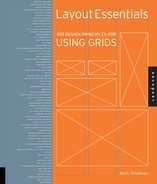Glossary
A SELECTION OF TERMS USED THROUGHOUT THE PRINCIPLES
Back Matter—Supportive material that is not part of the text and can includes items such as the appendix, notes, bibliography, glossary, and index.
CMYK—Cyan, magenta, yellow, and black (K), the four colors used in full-color process printing.
Column—A vertical container that holds type or images. Text in a column is measured horizontally.
Deck—Similar to a tagline
Flush Left—Text that is aligned (straight) on the left margin, with a right margin of varied—but not too greatly varied—widths. Uneven margins are also called “ragged.”
Flush Right—Text that is aligned (straight) on the right margin, with a left margin of varied widths.
Font—Digitally, a font is a single style of one typeface and is used in typesetting. Font is often used interchangeably (and incorrectly) with typeface. Think of font as production and typeface as design in hot metal, a complete assortment of type characters of one face and size.
Front Matter—In a book, copy preceding the main text, such as title page, copyright, and contents.
JPEG—Acronym for Joint Photographic Experts Group. A compression format used for images used on the Internet and not suitable for traditional printing.
Justify—To align text on both left and right margins of a column.
Layout—The arrangement of elements such as type and visuals on a page or screen.
Masthead—A list of people involved with a publication, along with their job titles. A masthead also contains information about the publication.
Negative Space—The space between shapes and masses, used mostly in referring to fine art, sculpture, or music.
Orphan—The first or last line of a paragraph that has become separated from the rest of its paragraph and is positioned at the bottom or top of a page or column, alone.
Perfect Binding—An adhesive binding technique. Edges of printing signatures are glued, then covered. The covered book is then trimmed cleanly on the remaining three sides.
Pica—A unit of measurement used for type. A pica is equal to 12 points. In Postscript printers, a pica is ⅙th of an inch.
Pixel—A square dot that represents the smallest unit displayed on a computer screen. (Stands for picture elements).
Point—A unit of measurement in typography. There are 12 points in a pica and approximately 72 points to the inch
RGB—Red, green, blue, the colors on computer monitors. Photoshop provides images in RGB when scanning. For most web offset printing, images must be printed as CMYK tiffs.
Running Head—Headings at the tops of pages that indicate the section and locations of materials. A running head can contain a page number, or folio. A running foot is the same element positioned at the page foot.
Running Text—Solid copy, normally not interrupted by headings, tables, illustrations, etc.
Saddle Stitched—Binding with wires, similar to staples.
Saturated—A color that contains little gray; an intense color. As saturation increases, the amount of gray decreases.
Silhouette—An image where the background has been eliminated, leaving only a figure or object.
Sink—Also called sinkage. The distance down from the topmost element on a page.
Spec—Formally called specification. Instructions for typesetting, now most often determined using the style sheets function of page layout programs.
Surprint—To lay down one ink on top of another.
Tagline—A slogan or a few lines extracted from text.
TIFF—Acronym for Tagged Image File Format. A format for electronically storing and transmitting bitmapped, grayscale, and color images. TIFF is the format desired for traditional printing.
Typeface—A type design with specific characteristics. Typefaces can have characteristics in common. One typeface can include designs for italic, bold, small caps, and different weights. The typeface is the design. See Font.
Typography—The style, arrangement, or appearance of typeset matter. The art of selecting and designing with type.
Web—The Internet.
Web Offset—Printing on a press designed to use paper supplied in rolls (printers use “web” to refer to the roll of paper). The image is offset from a blanket onto the paper.
White Space—Blank areas on a page or screen that do not contain text or illustrations.
Widow—A short line, word, or part of a word left bereft at the end of a paragraph. People often use widows and orphans interchangeably. The definition in this glossary is from The Chicago Manual of Style.
